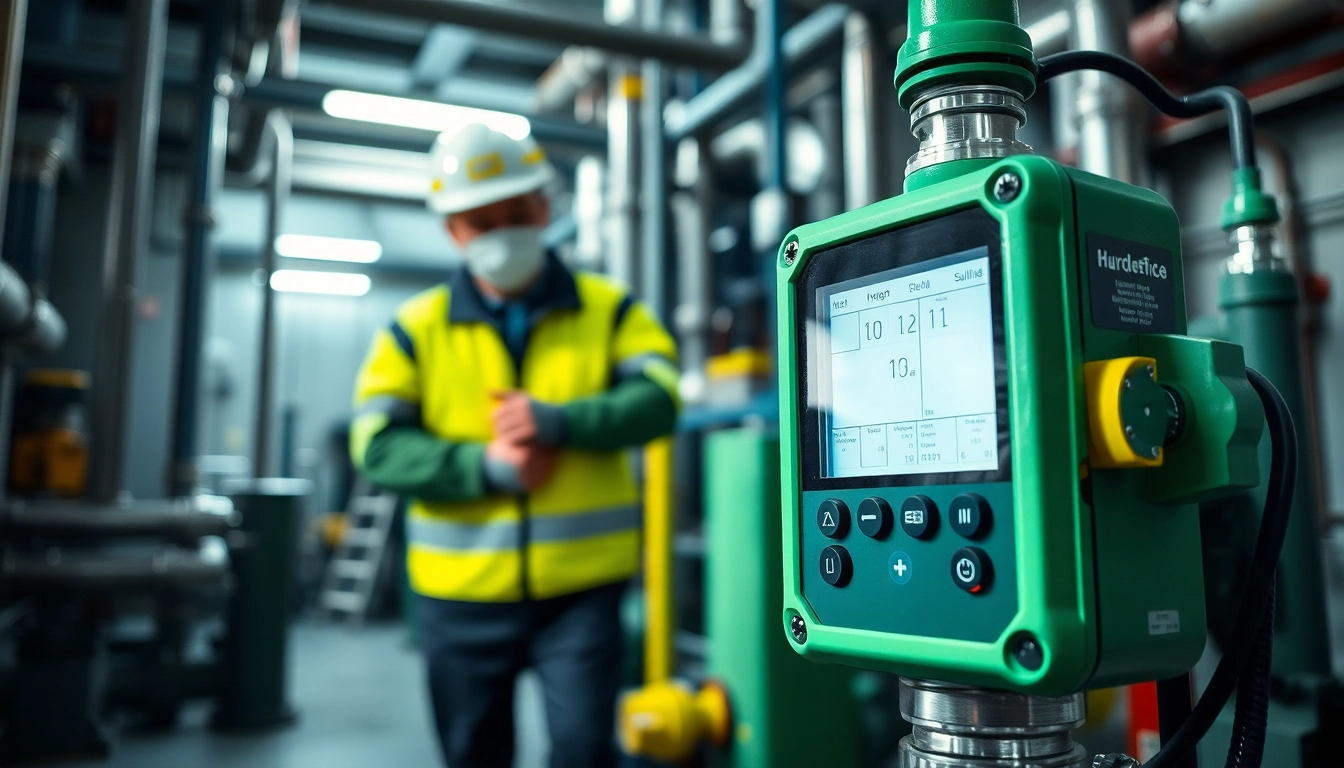Understanding Hydrogen Sulfide and Its Hazards
What is Hydrogen Sulfide?
Hydrogen sulfide (H2S) is a colorless gas that is notorious for its characteristic rotten egg odor. It is a naturally occurring compound often produced by the breakdown of organic materials in the absence of oxygen, such as in sewers, swamps, and volcanic gases. Industrially, hydrogen sulfide is generated during petroleum refining and natural gas processing, making it a pertinent concern in various sectors, including oil and gas, wastewater treatment, and mining.
Health Risks Associated with Hydrogen Sulfide
The health risks posed by hydrogen sulfide can be severe due to its toxic nature. Exposure can occur through inhalation in concentrations greater than 10 parts per million (ppm), leading to symptoms ranging from irritation of the eyes and respiratory tract to severe neurological effects and even fatality in higher concentrations. Recognizing the symptoms of exposure—such as headache, dizziness, and nausea—is critical. It is particularly dangerous because it can produce rapid unconsciousness and respiratory failure at high levels, leading to deaths in confined spaces or situations where proper ventilation is absent.
Importance of Detection in Industrial Environments
Given its high toxicity and prevalence in various industrial processes, the importance of effective Hydrogen Sulfide detection cannot be overstated. Early detection is essential to prevent serious health outcomes and ensure workers’ safety. Moreover, regulatory compliance mandates the implementation of gas detection systems to protect personnel and property, necessitating an investment in reliable detection technologies.
Hydrogen Sulfide Detection Technologies Explained
Types of Detection Equipment
There are several types of hydrogen sulfide detection equipment used across industries, classified primarily into two categories: portable detectors and fixed detectors. Portable detectors are handheld devices that offer real-time monitoring of hydrogen sulfide concentrations, which are essential for workers in hazardous environments or for those who must enter confined spaces. Conversely, fixed detectors are installed in specific locations to provide continuous monitoring of gas levels, alerting personnel to dangerous conditions immediately.
How Do Detection Devices Work?
Hydrogen sulfide detection devices utilize various sensing technologies, including electrochemical sensors, infrared sensors, and metal oxide semiconductors. Electrochemical sensors operate by detecting gas interactions at an electrode, generating a current proportional to the gas concentration. Infrared sensors work by measuring the absorption of infrared light—specific wavelengths of light interact differently with hydrogen sulfide, thus allowing for detection. Metal oxide semiconductor sensors change their resistance in the presence of hydrogen sulfide, which is then calibrated to indicate concentration levels.
Emerging Technologies in Gas Detection
The field of gas detection is continuously evolving, with emerging technologies enhancing the capability and reliability of hydrogen sulfide detection. Advances like wireless sensor networks and the Internet of Things (IoT) integration allow for real-time data transmission and remote monitoring. Moreover, machine learning algorithms are now being employed to predict gas release events based on historical data, thus providing a proactive approach to safety management. These innovations are paving the way for safer industrial environments and more effective hazard prevention strategies.
Implementing Hydrogen Sulfide Detection Systems
Best Practices for Installation
When implementing hydrogen sulfide detection systems, following best practices ensures optimal performance and reliability. Initial site assessments must identify areas where H2S is likely to be present, followed by the strategic placement of sensors in locations that maximize detection capability. Additionally, consideration must be given to environmental factors such as airflow and potential obstructions to ensure that the sensors can accurately detect gas concentrations. It is also vital to adhere to installation guidelines provided by manufacturers to avoid future operational issues.
Regular Maintenance and Calibration
For hydrogen sulfide detection systems to function effectively, routine maintenance and calibration are crucial. Manufacturers generally recommend periodic checks to ensure sensors are functioning as intended. Calibrating sensors at regular intervals, typically every six months to a year, allows for adjustments based on sensor drift, which might alter sensitivity levels over time. Implementing a strict maintenance schedule not only prolongs the life of the detection system but also ensures compliance with safety regulations, thus protecting workers and minimizing the risk of accidents.
Integrating Detection Systems with Safety Protocols
Integration of hydrogen sulfide detection systems with existing safety protocols enhances overall workplace safety. This can include linking alarm systems with evacuations plans, ensuring that alarms trigger immediate responses, and training employees on emergency procedures in case of a gas leak. Moreover, regular drills that incorporate detection systems are vital for ensuring workers understand how to respond effectively during emergencies, thereby reinforcing the safety culture within the organization.
Regulatory Standards and Compliance for Hydrogen Sulfide Detection
OSHA Guidelines for Workplace Safety
The Occupational Safety and Health Administration (OSHA) has stringent guidelines regarding hydrogen sulfide exposure in the workplace. These guidelines stipulate permissible exposure limits (PELs) and require employers to implement appropriate monitoring and preventive measures in environments where hydrogen sulfide is present. OSHA mandates the establishment of a safety program that includes identification of hazards, risk assessments, and the implementation of engineering controls, administrative controls, and personal protective equipment (PPE) to mitigate exposure risks.
International Standards for Gas Detection
In addition to OSHA guidelines, several international standards govern gas detection technologies and safety practices. For instance, standards set by the International Organization for Standardization (ISO) and the International Electrotechnical Commission (IEC) provide frameworks for the quality and performance of gas detection equipment. Compliance with these standards not only ensures equipment reliability but also signifies commitment to workplace safety, fostering confidence among employees and stakeholders alike.
Compliance Strategies for Businesses
To develop effective compliance strategies for hydrogen sulfide detection, businesses must engage in comprehensive risk management practices. This includes continuous monitoring of legislation developments and safety regulations, establishing internal compliance audits, and providing ongoing training for employees about hydrogen sulfide hazards and safety protocols. Implementing a responsive compliance program will not only facilitate adherence to legal requirements but also promote a safer work environment.
Case Studies: Successful Hydrogen Sulfide Detection Implementation
Industry Examples of Effective Detection
Several industries have successfully implemented hydrogen sulfide detection systems to improve safety outcomes. For example, in wastewater treatment facilities, operators have significantly reduced incidents of H2S exposure through the deployment of fixed detection systems. These systems alert personnel to rising gas levels, enabling timely interventions that safeguard worker health. Similarly, in the oil and gas sector, companies have invested in portable gas detectors for field workers, which have been instrumental in detecting leaks and preventing potential disasters.
Lessons Learned from Detection Failures
Despite advancements in detection technology, there have been several high-profile cases where failures to detect hydrogen sulfide led to catastrophic consequences. One notable case involved a mining operation where an absence of reliable H2S detection culminated in multiple fatalities. Investigations revealed that inadequate training and poor maintenance practices were key factors in the detection failures. Organizations can learn from these incidents by emphasizing the importance of training, maintenance, and reinforcing a culture of safety focused on continuous improvement.
Future Trends in Hydrogen Sulfide Detection Solutions
The future of hydrogen sulfide detection is set to be influenced by ongoing technological advancements. The convergence of artificial intelligence (AI) with gas detection systems is one significant trend, allowing for more accurate predictions and rapid responses to gas leaks. Furthermore, integration with wearable technology may provide workers with real-time notifications of hazardous conditions. As industries increasingly prioritize safety, these advancements will undoubtedly enhance the efficacy and reliability of hydrogen sulfide detection solutions.



